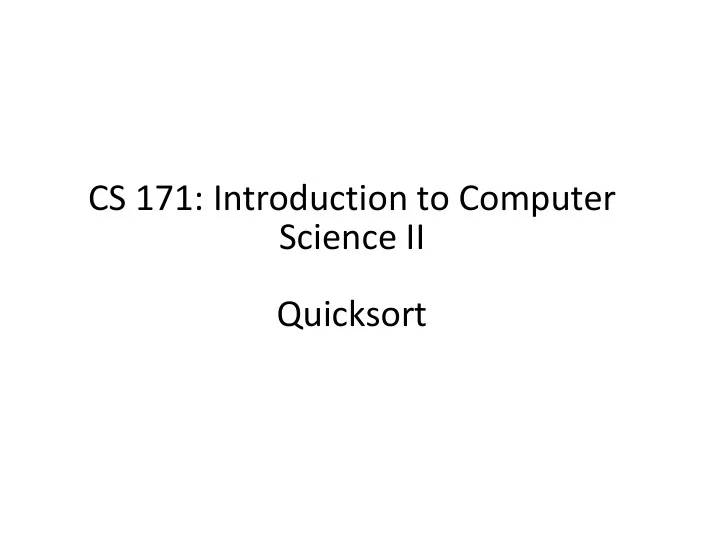

CS 171: Introduction to Computer Science II Quicksort
Welcome back from Spring break! � Quiz 1 distributed � Hw3 with 2 late credit is due 3/20 (today) � Hw4 with 1 late credit is due 3/21, with 2 late credits is due 3/24
Outline � Quicksort algorithm (review) � Quicksort Analysis (cont.) � Best case � Worst case � Average case � Average case � Quicksort improvements � Sorting summary � Java sorting methods
Quicksort Cost Analysis � Depends on the partitioning � What’s the best case? � What’s the worst case? � What’s the average case? What’s the average case?
Quicksort Cost Analysis – Best case � The best case is when each partition splits the array into two equal halves � Overall cost for sorting N items � Partitioning cost for N items: N+1 comparisons � Cost for recursively sorting two half-size arrays � Cost for recursively sorting two half-size arrays � Recurrence relations � C(N) = 2 C(N/2) + N + 1 � C(1) = 0
Quicksort Cost Analysis – Best case � Simplified recurrence relations � C(N) = 2 C(N/2) + N � C(1) = 0 � Solving the recurrence relations � N = 2 k � C(N) = 2 C(2 k-1 ) + 2 k � C(N) = 2 C(2 k-1 ) + 2 k = 2 (2 C(2 k-2 ) + 2 k-1 ) + 2 k = 2 2 C(2 k-2 ) + 2 k + 2 k = … = 2 k C(2 k-k ) + 2 k + … 2 k + 2 k = 2 k + … 2 k + 2 k = k * 2 k = O(NlogN)
Quicksort Cost Analysis – Worst case � The worst case is when the partition does not split the array (one set has no elements) � Ironically, this happens when the array is sorted! � Overall cost for sorting N items � Partitioning cost for N items: N+1 comparisons � Partitioning cost for N items: N+1 comparisons � Cost for recursively sorting the remaining (N-1) items � Recurrence relations � C(N) = C(N-1) + N + 1 � C (1) = 0
Quicksort Cost Analysis – Worst case � Simplified Recurrence relations C(N) = C(N-1) + N C (1) = 0 � Solving the recurrence relations C(N) C(N) = C(N-1) + N = C(N-1) + N = C(N-2) + N -1 + N = C(N-3) + N-2 + N-1 + N = … = C(1) + 2 + … + N-2 + N-1 + N = O(N 2 )
Quicksort Cost Analysis – Average case � Suppose the partition split the array into 2 sets containing k and N-k-1 items respectively (0<=k<=N-1) � Recurrence relations � C(N) = C(k) + C(N-k-1) + N + 1 � On average, � On average, � C(k) = C(0) + C(1) + … + C(N-1) /N � C(N-k-1) = C(N-1) + C(N-2) + … + C(0) /N � Solving the recurrence relations (not required for the course) � Approximately, C(N) = 2NlogN
QuickSort: practical improvement � The basic QuickSort uses the first (or the last element) as the pivot value � What’s the best choice of the pivot value? � Ideally the pivot should partition the array into two equal halves into two equal halves
Median-of-Three Partitioning � We don’t know the median, but let’s approximate it by the median of three elements in the array: the first, last, and the center. � This is fast , and has a good chance of giving us something close to the real median. something close to the real median.
Quicksort Summary � Quicksort partition the input array to two sub-arrays, then sort each subarray recursively. � It sorts in-place. � O(N*logN) cost, but faster than mergesort in practice � O(N*logN) cost, but faster than mergesort in practice � These features make it the most popular sorting algorithm.
Outline � Quicksort algorithm (review) � Quicksort Analysis (cont.) � Best case � Worst case � Average case � Average case � Quicksort improvements � Sorting summary � Java sorting methods
Sorting Summary � Elementary sorting algorithms � Bubble sort � Selection sort � Insertion sort � Advanced sorting algorithms � Advanced sorting algorithms � Merge sort � Quicksort � Performance characteristics � Runtime � Space requirement � Stability
Stability � A sorting algorithm is stable if it preserves the relative order of equal keys in the array � Stable: insertion sort and mergesort � Unstable:: selection sort, quicksort
Java system sort method � Arrays.sort() in the java.util library represents a collection of overloaded methods: � Methods for each primitive type � e.g. sort(int[] a) � Methods for data types that implement Comparable. � sort(Object[] a) � Method that use a Comparator � sort(T[] a, Comparator<? super T> c) � Implementation � quicksort (with 3-way partitioning) to implement the primitive-type methods (speed and memory usage) � mergesort for reference-type methods (stability)
Example � Sorting transactions � Who, when, transaction amount � Use Arrays.sort() methods � Implement Comparable interface for a transaction � Define multiple comparators to allow sorting by multiple keys keys � Transaction.java http://algs4.cs.princeton.edu/25applications/Transaction.java.html
Recommend
More recommend